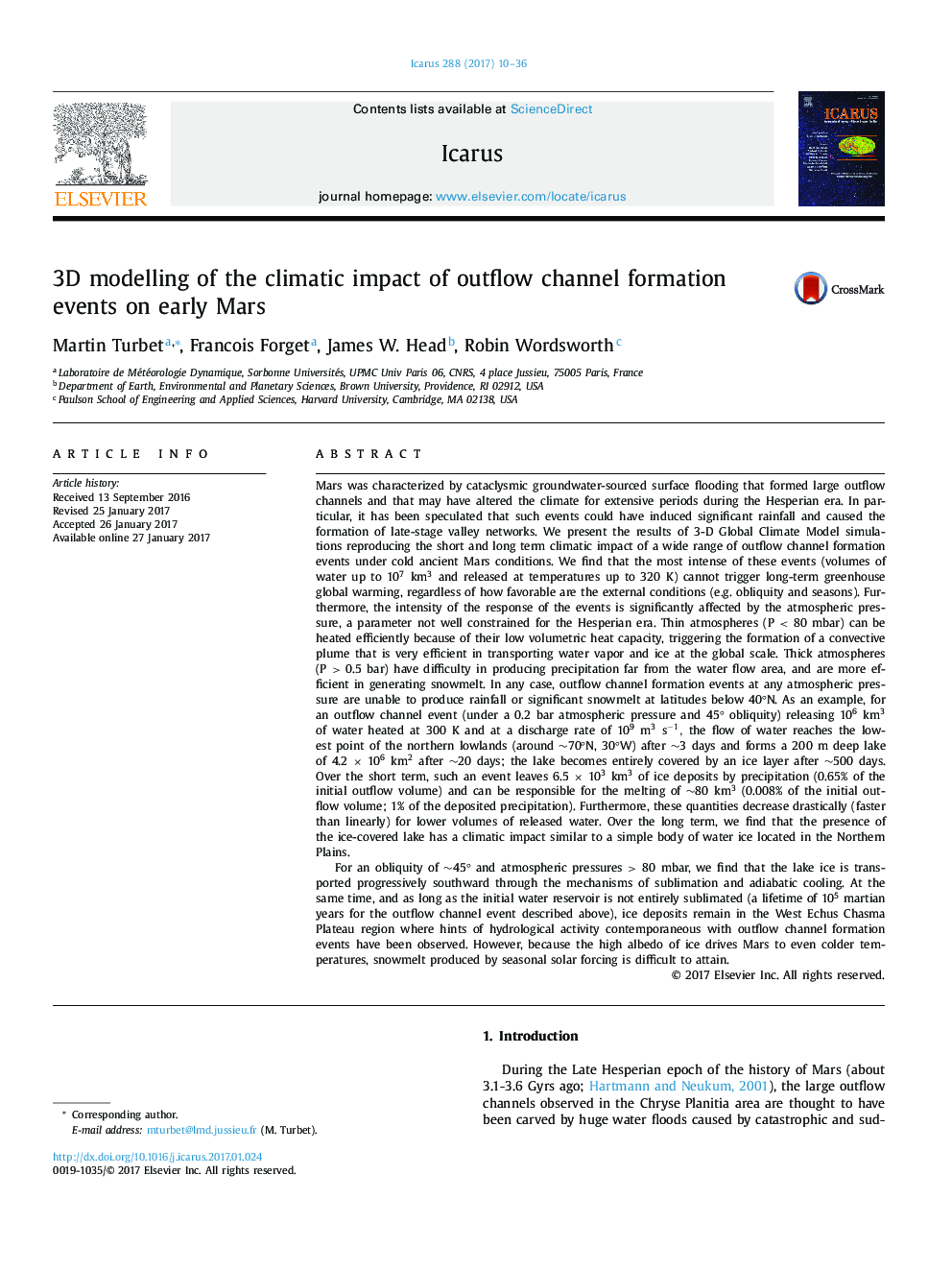| کد مقاله | کد نشریه | سال انتشار | مقاله انگلیسی | نسخه تمام متن |
|---|---|---|---|---|
| 5487077 | 1523503 | 2017 | 27 صفحه PDF | دانلود رایگان |
- Outflow channel formation events modelled with a 3-D GCM for the first time.
- The most intense of these events cannot trigger long-term greenhouse global warming.
- No rainfall or significant snowmelt at latitudes below 40° N.
- Atmospheric pressure is a key parameter to transport and melt water.
- Our work is a pathway towards future studies of extreme events on early Mars.
Mars was characterized by cataclysmic groundwater-sourced surface flooding that formed large outflow channels and that may have altered the climate for extensive periods during the Hesperian era. In particular, it has been speculated that such events could have induced significant rainfall and caused the formation of late-stage valley networks. We present the results of 3-D Global Climate Model simulations reproducing the short and long term climatic impact of a wide range of outflow channel formation events under cold ancient Mars conditions. We find that the most intense of these events (volumes of water up to 107 km3 and released at temperatures up to 320 K) cannot trigger long-term greenhouse global warming, regardless of how favorable are the external conditions (e.g. obliquity and seasons). Furthermore, the intensity of the response of the events is significantly affected by the atmospheric pressure, a parameter not well constrained for the Hesperian era. Thin atmospheres (P < 80 mbar) can be heated efficiently because of their low volumetric heat capacity, triggering the formation of a convective plume that is very efficient in transporting water vapor and ice at the global scale. Thick atmospheres (P > 0.5 bar) have difficulty in producing precipitation far from the water flow area, and are more efficient in generating snowmelt. In any case, outflow channel formation events at any atmospheric pressure are unable to produce rainfall or significant snowmelt at latitudes below 40°N. As an example, for an outflow channel event (under a 0.2 bar atmospheric pressure and 45° obliquity) releasing 106 km3 of water heated at 300 K and at a discharge rate of 109 m3 sâ1, the flow of water reaches the lowest point of the northern lowlands (around â¼70°N, 30°W) after â¼3 days and forms a 200 m deep lake of 4.2 Ã 106 km2 after â¼20 days; the lake becomes entirely covered by an ice layer after â¼500 days. Over the short term, such an event leaves 6.5 Ã 103 km3 of ice deposits by precipitation (0.65% of the initial outflow volume) and can be responsible for the melting of â¼80 km3 (0.008% of the initial outflow volume; 1% of the deposited precipitation). Furthermore, these quantities decrease drastically (faster than linearly) for lower volumes of released water. Over the long term, we find that the presence of the ice-covered lake has a climatic impact similar to a simple body of water ice located in the Northern Plains.For an obliquity of â¼45° and atmospheric pressures > 80 mbar, we find that the lake ice is transported progressively southward through the mechanisms of sublimation and adiabatic cooling. At the same time, and as long as the initial water reservoir is not entirely sublimated (a lifetime of 105 martian years for the outflow channel event described above), ice deposits remain in the West Echus Chasma Plateau region where hints of hydrological activity contemporaneous with outflow channel formation events have been observed. However, because the high albedo of ice drives Mars to even colder temperatures, snowmelt produced by seasonal solar forcing is difficult to attain.
Journal: Icarus - Volume 288, 15 May 2017, Pages 10-36
